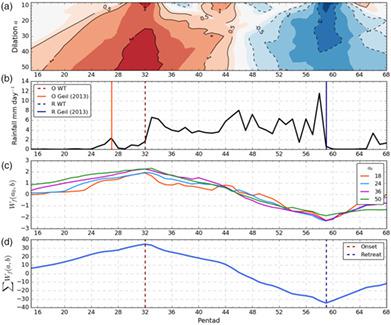当前位置:
X-MOL 学术
›
Int. J. Climatol.
›
论文详情
Our official English website, www.x-mol.net, welcomes your
feedback! (Note: you will need to create a separate account there.)
A wavelet transform method to determine monsoon onset and retreat from precipitation time-series
International Journal of Climatology ( IF 3.5 ) Pub Date : 2021-04-08 , DOI: 10.1002/joc.7130 Jorge L. García‐Franco 1 , Osprey Scott 1, 2 , Lesley J. Gray 1, 2
International Journal of Climatology ( IF 3.5 ) Pub Date : 2021-04-08 , DOI: 10.1002/joc.7130 Jorge L. García‐Franco 1 , Osprey Scott 1, 2 , Lesley J. Gray 1, 2
Affiliation

|
A new method to determine monsoon onset and retreat timings using wavelet transform methodology applied to precipitation time-series at the pentad scale is described. The principal advantage of this method is its portability, since it can be easily adapted for any region and dataset. The application of the method is illustrated for the North American Monsoon and the Indian Monsoon using four different precipitation datasets and climate model output. The method is shown to be robust across all the datasets and both monsoon regions. The mean onset and retreat dates agree well with previous methods. Spatial distributions of the precipitation and circulation anomalies identified around the onset and retreat dates are also consistent with previous work and illustrate that this method may be used at the grid-box scale, not just over large area-averaged regions. The method is also used to characterize the strength and timing of the Midsummer drought (MSD) in southern Mexico and Central America. A two peak structure is found to be a robust structure in only in 33% of the years, with other years showing only one peak or no signs of a bimodal distribution. The two-peak structure analysed at the grid-box scale is shown to be a significant signal in several regions of Central America and southern Mexico. The methodology is also applied to climate model output from the Met Office Hadley Centre UKESM1 and HadGEM3 CMIP6 experiments. The modelled onset and retreat dates agree well with observations in the North American Monsoon but not in the Indian Monsoon. The start and end of the modelled MSD in southern Mexico and Central America is delayed by one pentad and has a stronger bimodal signal than observed.
中文翻译:

从降水时间序列确定季风起退的小波变换方法
描述了一种使用小波变换方法确定季风开始和撤退时间的新方法,该方法适用于五阶尺度的降水时间序列。这种方法的主要优点是它的可移植性,因为它可以很容易地适应任何区域和数据集。使用四种不同的降水数据集和气候模型输出说明了该方法在北美季风和印度季风中的应用。该方法在所有数据集和两个季风区域中均表现出稳健性。平均开始和撤退日期与以前的方法一致。在开始和撤退日期前后识别的降水和环流异常的空间分布也与先前的工作一致,并说明该方法可用于网格框尺度,不仅仅是大面积的平均区域。该方法还用于表征墨西哥南部和中美洲仲夏干旱 (MSD) 的强度和时间。发现双峰结构仅在 33% 的年份中是稳健结构,而其他年份仅显示一个峰或没有双峰分布的迹象。在中美洲和墨西哥南部的几个地区,在网格框尺度上分析的双峰结构被证明是一个重要的信号。该方法也适用于气象局哈德利中心 UKESM1 和 HadGEM3 CMIP6 实验的气候模型输出。模拟的开始和撤退日期与北美季风的观测结果一致,但与印度季风的观测结果不一致。
更新日期:2021-04-08
中文翻译:

从降水时间序列确定季风起退的小波变换方法
描述了一种使用小波变换方法确定季风开始和撤退时间的新方法,该方法适用于五阶尺度的降水时间序列。这种方法的主要优点是它的可移植性,因为它可以很容易地适应任何区域和数据集。使用四种不同的降水数据集和气候模型输出说明了该方法在北美季风和印度季风中的应用。该方法在所有数据集和两个季风区域中均表现出稳健性。平均开始和撤退日期与以前的方法一致。在开始和撤退日期前后识别的降水和环流异常的空间分布也与先前的工作一致,并说明该方法可用于网格框尺度,不仅仅是大面积的平均区域。该方法还用于表征墨西哥南部和中美洲仲夏干旱 (MSD) 的强度和时间。发现双峰结构仅在 33% 的年份中是稳健结构,而其他年份仅显示一个峰或没有双峰分布的迹象。在中美洲和墨西哥南部的几个地区,在网格框尺度上分析的双峰结构被证明是一个重要的信号。该方法也适用于气象局哈德利中心 UKESM1 和 HadGEM3 CMIP6 实验的气候模型输出。模拟的开始和撤退日期与北美季风的观测结果一致,但与印度季风的观测结果不一致。











































 京公网安备 11010802027423号
京公网安备 11010802027423号